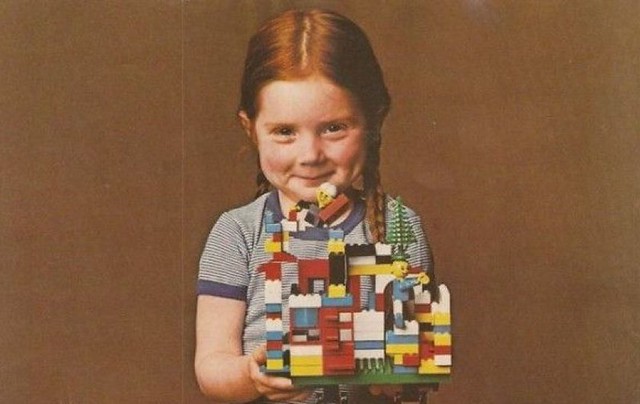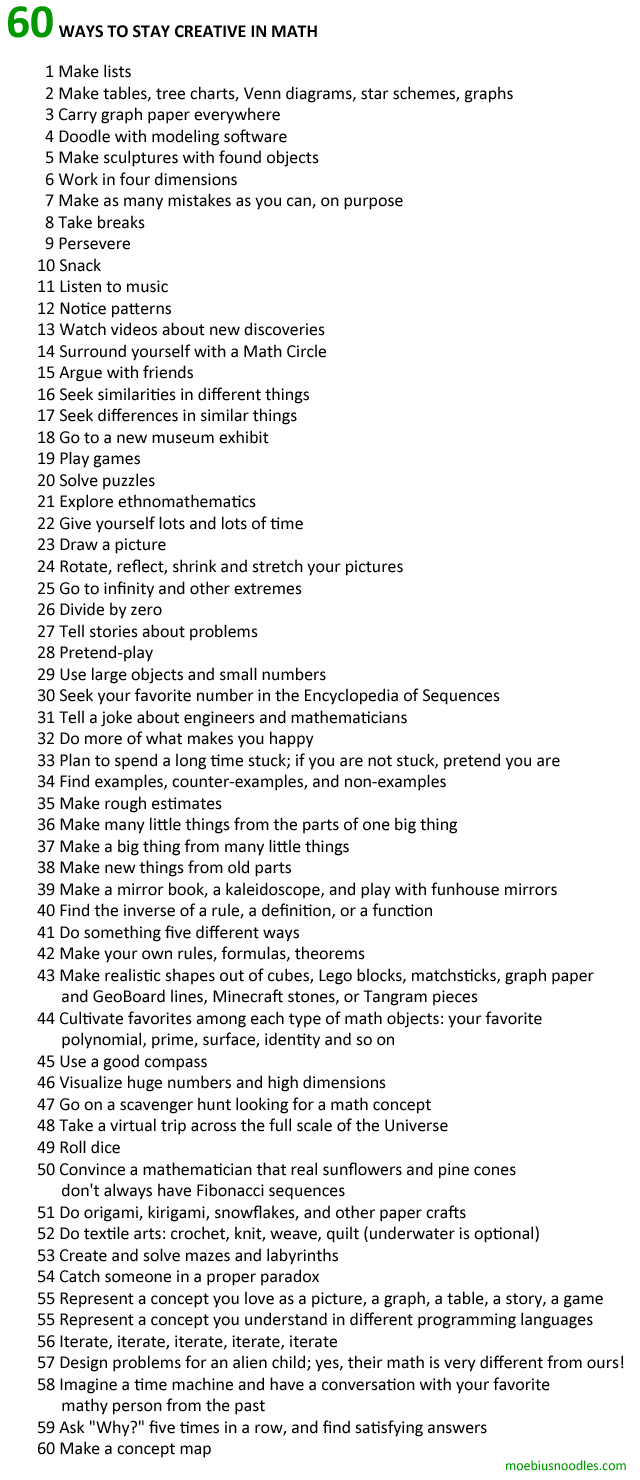Week 1 Task 2: Your child, the divergent thinking genius

Today your mission is…
Look at this mini-poster of 60 creative behaviors that support mathematics. Here is the same list in plain text. Recall an example of your child doing something from this list - either in mathematics, or in another context. In hindsight, what would have been a good way for you to support this creativity?

Ready, Set, Go
In Breakpoint and Beyond, George Land and Beth Jarman describe a longitudinal study they conducted on 1,600 kindergarten children ages three to five. They gave them eight tests on divergent thinking and an astonishing 98% of the children scored within the creative genius category. The researchers repeated the tests in five and ten years and separately tested adults. It gets worse and worse with time: only 2% of adults score at creative genius level. The good news is that grown-ups can collaborate with kids.
There are quite a few tasks children do better than adults, especially when adults support them. Other tasks adults do better than children, but even then adults can benefit from inspiration and prompts from children. In a harmonious learning environment, adults and children play complementary roles.
Adults
Children
Ideas
Write ideas down, sort and organize sets of examples, articulate knowledge
Generate diverse, creative, novel, unexpected ideas
Mathematics
Maintain consistency of patterns, extend patterns with new examples
Open up and maintain free play, break patterns to create new patterns
Process
Organize the process, manage time and tasks, maintain group well-being, nurture
Sense poor management practices, quickly show when well-being is in danger (“the canary”), invoke empathy and joy
Applications
Connect ideas to many life experiences and examples
Connect ideas to unexpected examples, look at familiar things from new angles
Aesthetics
Appreciate order and systems
Appreciate beauty and adventure
Frequently Asked Question
Can young children really understand advanced math concepts?
We believe that to be understood, a math concept (and pretty much anything else in life) has to be well-explained. The key is to search for age-appropriate explanations of advanced math concepts. For young children, the most appropriate explanation is through hands-on exploration and free play.
This means we need to find physical objects to represent mathematical concepts. But these should be objects that do not require prior knowledge to be played with. We call such objects and activities around them “grounded”. Grounded activities lower the risk of math anxiety. Plus, by selecting “no prerequisites required” activities, you avoid the “snowball effect” of sequential, prerequisite-filled learning.
The task
1. Find an example of a child’s creative behavior.
2. Do we have your example in our list of 60 behaviors, or should we add it?
3. How can grown-ups support the child in your example?
People who like this
Your answer

Answer by Percy · Apr 08, 2014 at 07:42 PM
My son expresses his creativity through creating inventions and musical composition. He needs the support of adults to provide interesting materials, long periods of uninterrupted time to explore inside and outdoors, someone to listen to his length explanations of his creations or songs, and someone to help him find the answers to his many questions.
Answer by jess · Apr 08, 2014 at 07:42 PM
1.During Centres time, some of my students were playing with Kapla blocks, creating structures and patterns. Working together, they arranged them in a pattern and began to add layers. They wondered how tall they could make the structure. When they ran out of blocks, we took a picture. Next they wondered how strong the structure was. They placed various items on the structure & it still held. They thought that perhaps it would hold one of them? At this point more students were becoming involved. I supported a student in climbing onto the structure. It was very exciting.
2. Notice patterns…
3. Grown ups can support by providing the materials, documenting the process, encouraging the testing & questioning of an idea, encouraging the excitement.
Answer by dnamkrane · Apr 08, 2014 at 07:42 PM
There's a lot here that both of my sons do, but "games" is something that they do together and frequently. The concept of "rules and regulations" comes up frequently, and they constantly butt heads about whether or not the good guy always has to win. For the most part I'm happy to stay out of the way, but I think it is my job to step up when needed and make sure things are done fairly by both. Games aren't fun if one person always gets their way, and that's not a lesson I want them to learn.
One of them really likes strategy games like chess, while the other likes puzzles. I think they're both getting to the same thing, but using a different route. I'm happy to do both with them.
Answer by Brianna · Apr 08, 2014 at 07:31 PM
My kids have done some really fun dramatic play. For a while- they were playing restaurant (together!) and my 7-year-old would order food and my 5-year-old would prepare it for him. I would love to support this type of play more by taking them to a restaurant (or a doctor's office or a grocery store) and really thinking about all the things that happen there. Then I could help them to integrate this understanding into their play. (Other creative things that I am so happy to see are my 5 year old asking "Why? Why? Why?" and lots and lots of construction around our house. They build some truly wonderful things. And it is wonderful for me when they play with toys in non-traditional ways.-- My little guy would pick up anything and pretend it was a telephone to call his Nona or his favorite teacher. :) ) p.s. Thanks for this awesome list! Inspired by so many great ideas! (Used to love doing math scavenger hunts in the classroom and would love to do some at home too!)
Answer by Nelleke · Apr 08, 2014 at 05:46 PM
For about two months, my 5-year-old used his snack at teatime to create math equations. He would use the strips of cheese to create plus and minus signs, and arrange slices of apple, crackers, etc. to stand for the numbers. Then he'd ask me the answer. "Mama, what is one minus two?" "One less than zero," I'd tell him. "Some people call it negative one." So, yes, you have "snack" in your list of 60 behaviours, and I supported him by answering his questions or bouncing them back at him to figure out.
Answer by oxanavashina · Apr 08, 2014 at 04:06 PM
My younger son loves to jump, climb, roll, dance - move, in short. I sometimes try to make a game out of it - ask him e.g. if he can walk like a table. Or would he like to be a lawn mover, me holding his feet. Or ask him questions so that he tells me a story of his being Zorro and climbing a high wall to resque a friend. Short, I try to create a context and a play out of what he does. The elder ones loves to build contraptions out of basically any garbage. I have to provide ressources and organize the workspace - meaning I have to make sure that we have enough cardboard, plastic bottles, wire, electronic modules etc. Moral support as well - in case something doesn't work as expected - and in case it does!
Answer by yileinei · Apr 08, 2014 at 02:03 PM
My daughter loves jigsaws puzzles, so we sometimes take photos of our family and cut them with scissors to put them back together. We often change the pieces so we can make different faces i.e. mum with dad's eyes, or one face with another's hair, etc. She loves playing that!
Answer by perbui · Apr 08, 2014 at 01:27 PM
Number 2: make tables, charts, Venn diagrams, schemes, graphs
I taught my then 6-year-old daughter how to make Venn diagrams one day, and the next morning I found her trying to categorize plant-based foods into a three-way Venn diagram labeled "roots," "leafy veggies," and "starches." (She has this thing about eating well-balanced meals and finds my never-ending argument with my wife over where corn should be categorized amusing.) The problem was that I had never taught her how to do a three-way Venn diagram, so she had the circles side by side, with only two circles overlapping at a time, rather than having all three circles intersecting in the middle. I helped her to re-draw the Venn diagram, and then proceeded to help her write down the plants she had already listed while she told me where to place them. I started naming off other edible plants, and she was off. Finally, I asked her whether she had ever thought about seeds and where they should be categorized. In this example, I helped her in the process when she got stuck. I helped to organize her ideas and to write and record so that she could focus on generating ideas and doing the critical thinking. I extended the pattern with more examples for her to think about. I thought her use of the Venn diagram to be quite creative!
Answer by nikkilinn · Apr 08, 2014 at 01:29 PM
My daughter (5) enjoys creating clothes for her dolls, sometimes with paper, sometimes with whatever fabric we have around the house. She draws and pieces together some very cute and creative pieces. I support her by keeping all of the craft supplies within her reach so when the inspiration strikes, she doesn't have to wait for me to have a moment to get something for her. I am also her head tape assistant and stapling assistant, and sometimes security guard when her little sister (3) decides to "help". :)
Answer by Elizabeth02 · Apr 08, 2014 at 01:11 PM
My son likes to create his own games. They often have simple math elements, but also a lot of creation and revision to make the game go well. I usually try to help him with the problem solving process, by asking questions about why some element isn't working well, and what can be done to make it better. I gauge whether his frustration level could take another mess up & re-try, or if he needs a little more help so he doesn't give up entirely. The best support here is to take the time to play the game with them and enjoy.
Answer by Sblair · Apr 08, 2014 at 12:54 PM
Number 20. Solve Puzzles.
For us, we love to put together actual jigsaw puzzles. Use this opportunity to look at the box, note the piece count. Help the child separate the ends from the center pieces, then count each group. Create an addition problem and note the total piece count. As the puzzle is almost finished, around 10 or 15 pieces left, estimate how many pieces are currently connected then count the remaining loose pieces and subtract from the total from the beginning of the project to get the actual total. Examine how the puzzle looks minus the remaining pieces. Perhaps discuss the time and days the puzzle took to complete. Multiply the total number of pieces by the active hours working on it to calculate the number of pieces worked on per hour. Making mention of the difficulty or ease a particular puzzle had. Help the child correlate this factor when choosing another puzzle, mentioning time constraints during the week that could also pose a delay in completing the puzzle.
Follow this Question
Related Questions
Week 1 Task 1: Your mathematical dreams and worries 146 Answers
Week 1 Task 3: Patterns and adaptations 56 Answers
Week 1 Task 4: What is multiplication? 42 Answers
Week 1 Task 5: Citizen science project - signs of dangers 36 Answers

